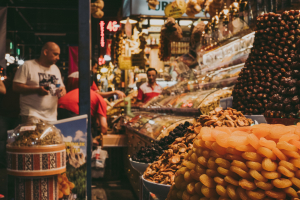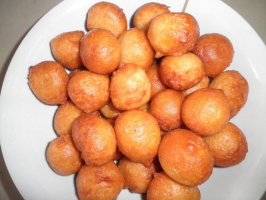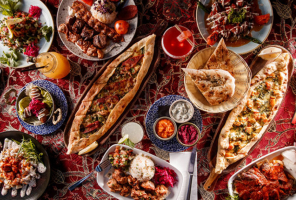Top 12 Best Syrian Foods
Syria's traditional cuisine is a diverse menu of dishes that is home to Arabs, Kurds, Greeks, and a plethora of other minorities from the surrounding ... read more...region. It makes use of a wide range of ingredients from the Mediterranean, Western Europe, and the Middle East. If you're planning a trip to Syria and want to get a taste of the local cuisine, Toplist hopes our list of the Top 12 greatest Syrian cuisines will point you in the right direction.
-
Kubbeh (or kibbeh) also known as kubbe is the name given to a related group of dishes that are frequently referred to as Syria's national dish. They consist of a filled dumpling soup with a variety of fillings and soup broths. Once almost exclusively made at home by members of the Iraqi and Kurdish communities, the dish's popularity has spread to Israelis of all backgrounds since the early twentieth century, and it is now commonly served in restaurants across the country.
It is deep-fried, baked, grilled, or raw bulgur wheat combined with spiced minced lamb to form a paste that is then shaped. Kubbeh is typically shaped like an egg, but its name comes from the Arabic word for ball. It is part of Syria's meze plate tradition, in which small portions of a variety of dishes are placed on a table.
Kubbeh nayyeh is a dish that is served raw, similar to steak tartare. Kubbeh kishk is a soup in which the balls are covered in a broth made of butter, yogurt, and cabbage leaves.

en.wikipedia.org 
thoidai.com.vn -
Manakish, also known as manousheh when spoken in the singular form, can include minced meats, though vegetarian versions are available. This dish is distinguished by topping a pre-cooked flatbread with additional ingredients, much like a pizza. Manakish can be served simply with the herb thyme or with the za'atar spice mix, which includes thyme, oregano, and sesame seeds among other herbs. Manakish can also be topped with local cheeses such as akkawi or minced lamb. The minced meat is usually combined with finely chopped tomatoes in this case.
Manakish has a variety of responsibilities to play in the Syrian dinner that you should not overlook. The thin bread known as manakish is the cornerstone of Syrian cuisine, and with a variety of flavors and fillings to choose from, it's the ideal brunch or breakfast alternative. The akawiost, egg, and parsley variation, which hails from Damascus, is one of the most popular options. Mohmmara with cheese and meatballs and fatayer, which has the right balance of cheese and olives, are two other great options. Manakish is most usually served folded or in bits, and while you could compare it to pizza, that would be a disservice to one of Syria's most delectable appetizers.

bayut.com 
en.wikipedia.org -
While not unique to Syria, falafel are an integral part of the country's traditional cuisine. These deep-fried balls are typically made by blitzing cooked chickpeas, but falafel can also be made with fava beans.
Despite the fact that these protein-rich chickpea fritters are listed as one of Israel's national dishes, it is often speculated that falafel originated in Egypt, Lebanon, or Palestine. By the 1950s, Yemenite immigrants in Israel began making falafel on the streets and selling it wrapped in paper to make a living, transforming this ancient dish into an early form of Israeli fast food.
Falafel is traditionally topped with a variety of accompaniments and served alone, as part of a meze platter, or with flatbread to form a type of sandwich. Tahini (sesame dip) and chilli sauces, fresh salad, and pickled vegetables are among them. Spices such as cumin and coriander give falafel their distinct and delectable flavor.

fridaymagazine.ae 
zaatarandzaytoun.com -
When it comes to sweet dishes, baklava is unquestionably the most common in Syria. These small bites are an important part of the country's café culture, where men, in particular, meet for tea or coffee. Baklava is a sweet pastry made from filo pastry that is either layered or shredded to resemble spaghetti and wrapped around chopped nuts. It arrived in Syria during the Ottoman period.
The dish's two components are held together by the liberal use of honey or syrup, which makes each piece of baklava extremely rich and sweet on the tongue. Baklava filled with chopped pistachios is said to have been invented in the 1870s by a chef in the Syrian capital, while other versions use chopped walnuts or hazelnuts, all of which are native to the region. If you intend to travel to Syria, this meal is one of the must-try dishes.

sunset.com 
plantbasedfolk.com -
Fattoush is a salad made of cucumbers, lettuce, tomatoes, radishes, and any other fresh vegetable combination that is available. The main ingredient is torn or chopped up flatbread that has been toasted or fried beforehand.
Fattoush can have a simple flavor due to the ingredients used, but this base flavor is enlivened by the addition of fresh herbs, including sumac, which gives the dish a slightly sour note. Sumac is a lemony red, purple-ish powder used to season meats and vegetables. It grows wild in Palestine and is a key ingredient in the country's famous chicken dish, msakhan. Syrians enjoy using the spice on fattoush and occasionally as a garnish for hummus.

thehappyfoodie.co.uk 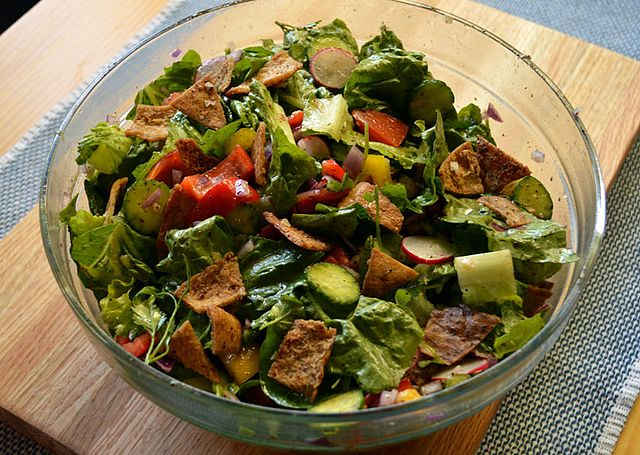
en.wikipedia.org -
If you've eaten Turkish food before, you might recognize muhammara as acuka. In either case, the dish is the same: a paste or thick dip made primarily of crushed chili peppers.
Aleppo peppers, which were born in the Syrian city of Aleppo, are commonly used, either fresh or dried. They are rated as relatively mild, providing the dish with a heat that isn't overpowering. The other ingredients in muhammara then add a subtle sweetness that complements the peppers' natural profile. Crushed walnuts, spices like cumin, pomegranate juice, or molasses, and breadcrumbs are among them. Muhammara can be eaten with bread or as a sauce or marinade for kebabs and other popular grilled meats in the country.

sunnysidehanne.com 
tastespace.wordpress.com -
There is no shortage of kebabs in Syria's traditional cuisine. In fact, there are at least 25 different types of Syrian kebab, also known as kebab halabi or Aleppo kebabs.
The most common meat used is probably minced lamb pressed onto a metal skewer and slowly cooked over charcoal to keep the meat juicy and succulent. For example, siniyyet kebab is made with minced lamb and served on a plate with chilli, onions, and tomatoes.
Beef, on the other hand, can be used, as in the preparation of kebab khashkhash. This type of kebab is flavored with parsley, garlic, and pine nuts, as well as a traditional chilli pepper paste called muhammara.
The most unusual type of kebab to seek out is kebab karaz, which is made from lamb meatballs stewed with small sour cherries known as St Lucie cherries. As a result, the dish is brown-purple with sweet and sour flavors.

zaatarandzaytoun.com 
en.wikipedia.org -
Most Syrian meals end with a bite of something sweet rather than a dessert. These sweets, known as halawat el jibn, can be found in most restaurants, as well as cafes and bakeries in even the smallest towns. Halawat is thought to have originated in the Syrian city of Hama in the country's west, though it's also possible that the dish originated in nearby Homs as a specialty.
Halawat are made with an akkawi cheese dough, semolina, and sugar syrup, then filled with cream and topped with crushed pistachios. Some recipes substitute mozzarella for the akkawi, and many call for the addition of rose water or orange flower water to create an aromatic flavor.
All of the ingredients are combined and heated until a soft, pliable dough forms, which is then rolled into thin sheets. The filling is made with ashta, which is thick clotted cream piped onto the sheets before they are rolled into thin logs. The rolls are then sliced into small bite-size pieces and served drizzled with syrup and topped with rose petal jam and ground pistachios.

alchetron.com 
salloura.com -
Booza is a type of ice cream that originated in the Levant and the Middle East. Booza is thickened with salep, an orchid root thickener, and mastic gum, a resin obtained from mastic trees, in addition to the standard ingredients of milk, cream, and various flavoring additions.
The mixture is then pounded with wooden mallets until it achieves its distinct, stretchy consistency. Booza produces flavor-packed ice cream with an amazingly dense and creamy texture because no eggs or air are added. The most traditional flavor of booza is kashta or qashta, which is a type of clotted cream often flavored with orange blossom and rose water, but other common flavorings include fruit, chocolate, and nuts.
Booza, often referred to as one of the oldest ice cream flavors, has recently gained popularity outside of its home country, primarily in the United States. Similar ice cream flavors can also be found in Turkey (dondurma) and Greece (kaimaki).
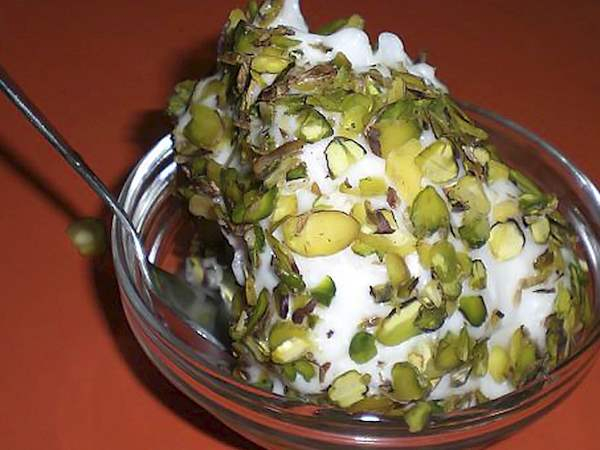
Booza 
en.wikipedia.org -
Yalanji is a cold Syrian appetizer made with grape leaves packed with rice and a variety of vegetables. Yalanji is a Turkish term that meaning "liar," and it gets its name from the lack of flesh in the filling. Yalanji is a term used in the culinary industry to describe vegetarian stuffed vegetables or dolmas. This is because traditional dolmas are stuffed with a fragrant meat and rice mixture, but yalanji dolmas are "fake" because they are vegetarian.
Yalanji are vine leaves that have been stuffed with cooked rice and mixed vegetables. They are slowly simmered with lemon juice to allow the leaves to impart their flavor to the other ingredients before serving cold as an appetizer to a main course. Bell peppers, tomatoes, and onions are common vegetables used in stuffing. This is then seasoned with herbs and spices such as b'har, mint, garlic, and pomegranate molasses from Syria. The filling is the true star of yalanji. The vegetable on the outside serves only as a vehicle for the tasty vegetarian stuffing inside. Grape leaves and even tiny baby eggplants are commonly used to stuff yalanji, but silky swiss chard leaves can also be employed.
Yabrak, a similar dish of vine leaves stuffed with rice and minced meat, is served hot as a main course.

196flavors.com 
omayahcooks.com -
Shawarma is a Middle Eastern meal that originated in Turkey and expanded throughout the Middle East until the Ottoman Empire fell apart in the early twentieth century. While many people associate shawarma with the resulting wrap or sandwich, it actually refers to the method of cooking thin slices of meat on a large rotating spit. Any meat can be cooked in this manner, but lamb or chicken are the most common in restaurants.
Chefs shave off pieces of the stacked slices as the spit rotates in front of a flame or heating element. They're stuffed into a wrap or pita bread with fresh chopped tomatoes and salad vegetables, grilled peppers, pickles, tahini, hummus, and French fries. Shawarma can be found on the street and make an excellent lunch.
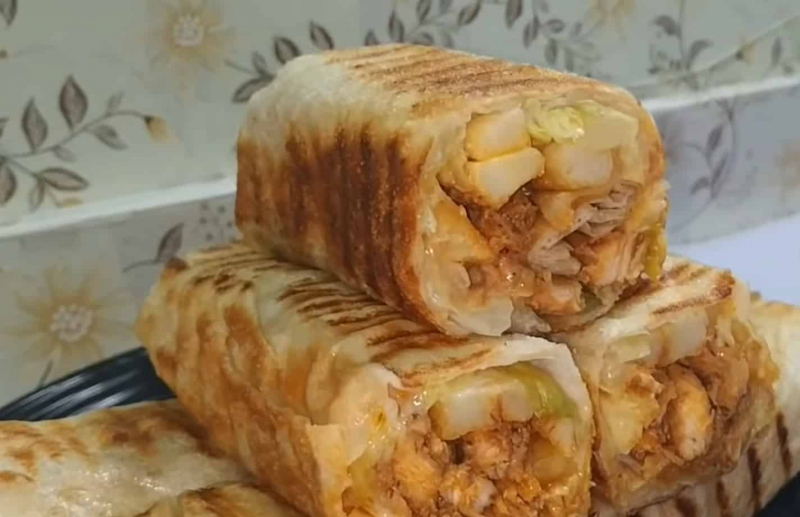
arabicfoodtips.com 
tazaxpress.ca -
Fatteh is derived from the Arabic word for crumbled, as this dish, like fattoush, contains broken up pieces of bread. The bread can be fresh or toasted, though it appears that fatteh was traditionally one of the ways to use up stale bread. Fatteh is just another type of hummus. Consider it hummus on steroids. It includes everything you want in a hummus, such as toasted pita bread and seasoned meat.
Fatteh is especially popular in Damascus and can be eaten as a main course or for breakfast the next morning. Khubz flatbreads are typically used, which are broken up and topped with yogurt, chickpeas, and a drizzle of olive oil. This serves as the foundation for fatteh, to which cumin is added. Other ingredients, such as grilled aubergine (egg plant) or small cubes of lamb, can be used to round out the dish.

usahello.org 
cookpad.com




















